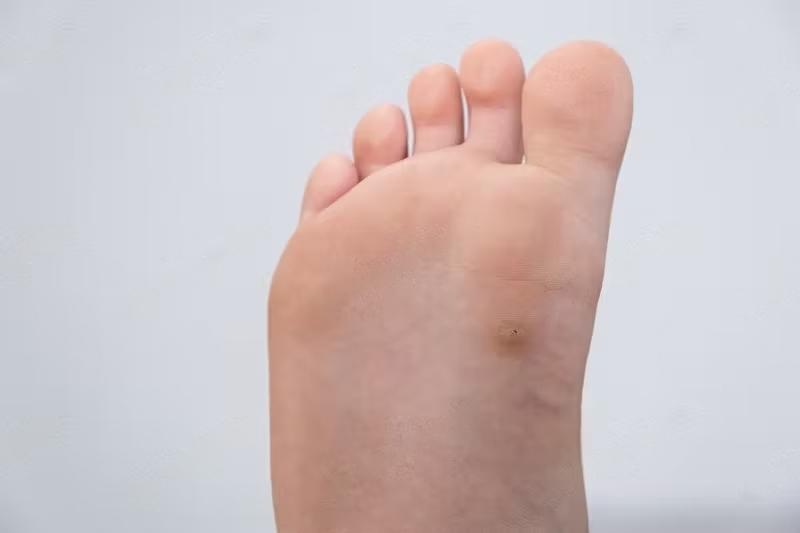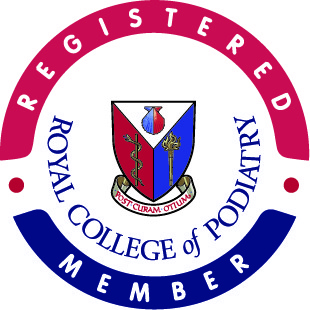VERRUCA NEEDLING
Step into a pain-free future with our advanced verruca needling treatment – experience the effective solution for stubborn verrucae.

Services
WHAT IS VERRUCA NEEDLING?
While a verruca may be visible to the eye, it stays hidden from your immune system, allowing it to survive and spread.
Verruca needling is a specialised treatment aimed at addressing stubborn verrucae. This minimally invasive procedure is performed under local anaesthesia (numbing) and involves puncturing the verruca with a fine needle, stimulating the body’s immune response by causing controlled trauma. This process brings the verruca to the attention of the immune system, allowing it to effectively combat the virus. Similar to a vaccination, verruca needling aims to make the verruca visible to the immune system, leading to a targeted response.
Before undergoing verruca needling, it is important to have an initial assessment by one of our experienced podiatrists to receive the right diagnosis and ensure the suitability and safety of the needling technique for you.
Verruca needling is often considered when other traditional treatments, such as topical creams have proven ineffective in resolving the verruca. This procedure has gained popularity due to its high success rates and minimal post-treatment discomfort, making it a promising option for those seeking an effective and efficient solution for verruca removal.
WHAT DOES VERRUCA NEEDLING TREAT?
Verruca needling is primarily used to treat verrucas, also known as plantar warts, which are rough, small growths that typically appear on the soles of the feet. These warts are caused by the human papillomavirus (HPV) and can be painful, especially when located on weight-bearing areas of the foot.
Verruca needling aims to effectively eliminate these stubborn warts by stimulating the body’s immune response to target and remove the verruca. This treatment is often considered when other conventional methods have proven unsuccessful in resolving the verruca.
HOW WILL VERRUCA NEEDLING HELP ME?
Verruca needling can offer several benefits in treating verrucas. Here’s how it can help you:
Effective Treatment: Verruca needling has shown high success rates in eliminating verrucae, especially those that have been resistant to other treatments.
Minimally Invasive: The procedure is minimally invasive, typically causing minimal discomfort during and after the treatment.
Stimulates Immune Response: verruca needling stimulates the body’s immune response, encouraging the immune system to target and remove the wart.
Potential for Fewer Recurrences: Some patients find that verruca needling may reduce the likelihood of verruca recurrence compared to other treatments.
Relief from Symptoms: As the verruca is treated, patients often experience relief from pain or discomfort associated with the wart.
It’s important to consult with a qualified HCPC registered Podiatrist to understand how verruca needling specifically applies to your individual case and to determine if it’s the right treatment option for you.
HOW DOES VERRUCA NEEDLING WORK?
Verruca needling, also known as Falnor’s needling, is a procedure designed to treat verrucas through a targeted approach. Here’s an overview of how verruca needling works:
1
Preparation:
2
Needling:
3
Inflammatory Response:
4
Healing Process:
Verruca needling harnesses the body’s natural immune response to target and eliminate the verruca, potentially leading to a more comprehensive and lasting resolution.
After the procedure, proper wound care and follow-up appointments with a podiatrist are essential to monitor the healing process and address any concerns.
LET'S ANSWER YOUR VERRUCA NEEDLING QUESTIONS!
Verruca needling is generally considered safe, but like any medical procedure, it may be associated with certain side effects. Common side effects may include temporary discomfort, redness, swelling, and minor bleeding at the needling site. In some cases, patients may experience a temporary increase in pain or sensitivity at the treated area. Additionally, there is a risk of infection, although this is rare when proper post-treatment care is followed. It’s important to discuss potential side effects with a podiatrist before undergoing verruca needling to gain a comprehensive understanding of what to expect and how to manage any post-treatment symptoms.
The healing timeline following verruca needling can vary from person to person. Typically, the initial healing phase may take around 1 to 2 weeks, during which the puncture sites will scab over and eventually heal. However, complete resolution of the verruca may take several weeks to months, as the body’s immune system responds to the needling and works to eliminate the wart. It’s important to follow the post-treatment care instructions provided by your Podiatrist to promote proper healing and minimise the risk of complications. Regular follow-up appointments can also help monitor the healing progress and address any concerns that may arise during the recovery period.
Compared to other verruca removal methods, verruca needling is a quick solution, with recorded success rates of up to 69%.
Notably, verruca needling typically requires only one session of treatment, and it can initiate a systemic immune response, potentially leading to the spontaneous resolution of multiple verrucae. It’s important to note that while results are promising, individual outcomes may vary, and guaranteed results cannot be assured. It’s advisable to consult with a Podiatrist to determine the most suitable treatment approach based on your specific circumstances.
To minimise the risk of getting verrucas, it’s important to practice good foot hygiene and take preventive measures. Keeping your feet clean and dry, changing socks daily, and inspecting the feet regularly for any signs of verrucas are also important steps in prevention. A healthy diet also plays a large role in your body’s ability to fight infections.
Verruca needling is performed under local anaesthetic to numb the area affected by the verruca. Therefore, you shouldn’t experience any pain during the procedure.
Some people may experience a little bruising or discomfort as the anaesthetic wears off, but this is usually mild enough to not require painkillers. Some patients feel minor soreness for one to three days following the treatment. We also recommend avoiding anti-inflammatories as there’s a theoretical chance that they may reduce your body’s immune response to the needling procedure.
VERRUCA NEEDLING IN BEDFORD WITH MYFOOTMEDIC
Welcome to our state-of-the-art clinic in Bedford, where we are fully equipped to address all your foot care requirements. If you are seeking a reliable solution for plantar wart removal, feel free to reach out to the MyFootMedic team to explore our verruca needling treatments.
Contact us today to schedule an appointment, and our experienced podiatrists will conduct a thorough assessment, provide an accurate diagnosis, and administer tailored treatment for your verruca using the most suitable techniques.



